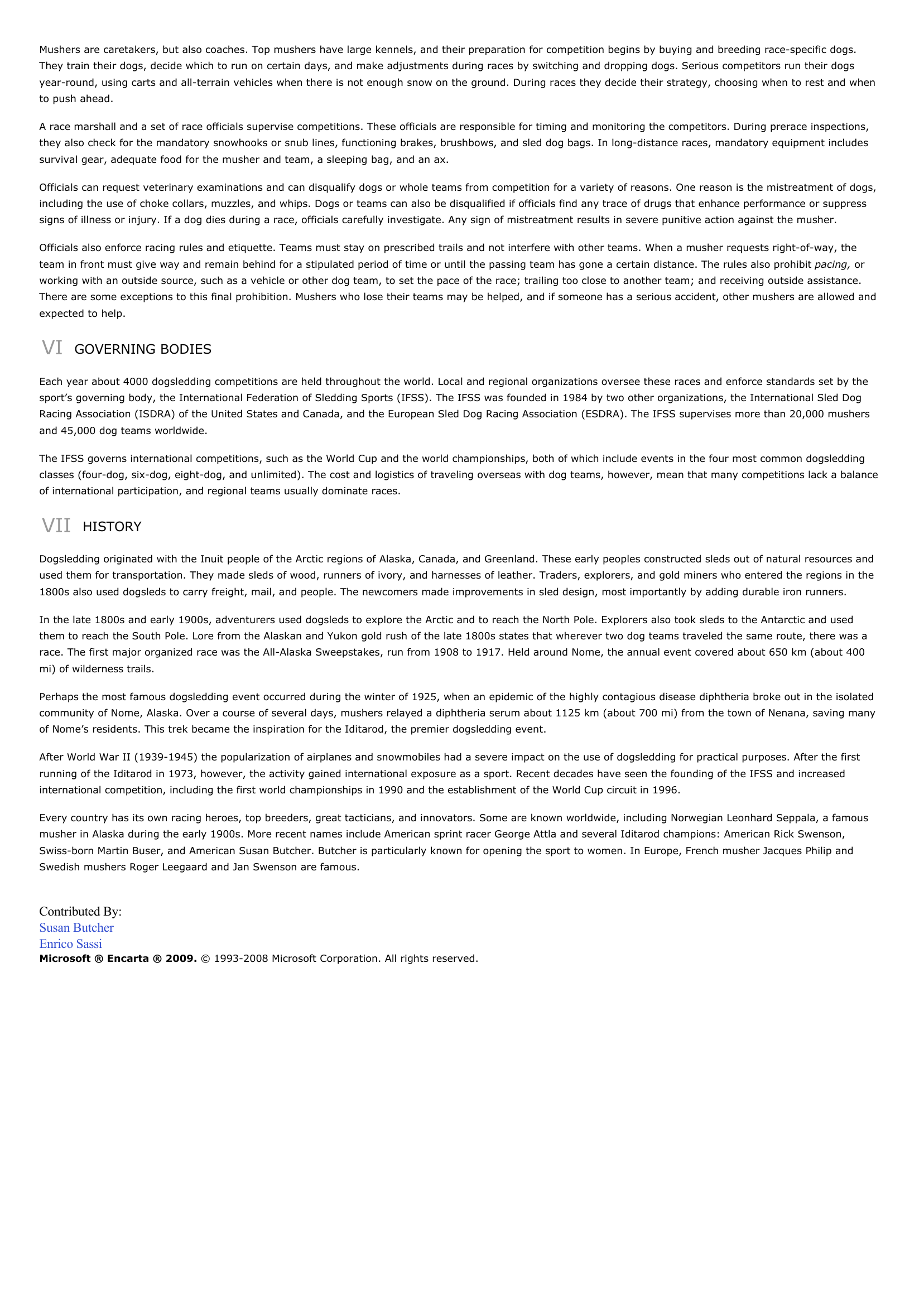Dogsledding.
Publié le 14/05/2013

Extrait du document
«
Mushers are caretakers, but also coaches.
Top mushers have large kennels, and their preparation for competition begins by buying and breeding race-specific dogs.They train their dogs, decide which to run on certain days, and make adjustments during races by switching and dropping dogs.
Serious competitors run their dogsyear-round, using carts and all-terrain vehicles when there is not enough snow on the ground.
During races they decide their strategy, choosing when to rest and whento push ahead.
A race marshall and a set of race officials supervise competitions.
These officials are responsible for timing and monitoring the competitors.
During prerace inspections,they also check for the mandatory snowhooks or snub lines, functioning brakes, brushbows, and sled dog bags.
In long-distance races, mandatory equipment includessurvival gear, adequate food for the musher and team, a sleeping bag, and an ax.
Officials can request veterinary examinations and can disqualify dogs or whole teams from competition for a variety of reasons.
One reason is the mistreatment of dogs,including the use of choke collars, muzzles, and whips.
Dogs or teams can also be disqualified if officials find any trace of drugs that enhance performance or suppresssigns of illness or injury.
If a dog dies during a race, officials carefully investigate.
Any sign of mistreatment results in severe punitive action against the musher.
Officials also enforce racing rules and etiquette.
Teams must stay on prescribed trails and not interfere with other teams.
When a musher requests right-of-way, theteam in front must give way and remain behind for a stipulated period of time or until the passing team has gone a certain distance.
The rules also prohibit pacing, or working with an outside source, such as a vehicle or other dog team, to set the pace of the race; trailing too close to another team; and receiving outside assistance.There are some exceptions to this final prohibition.
Mushers who lose their teams may be helped, and if someone has a serious accident, other mushers are allowed andexpected to help.
VI GOVERNING BODIES
Each year about 4000 dogsledding competitions are held throughout the world.
Local and regional organizations oversee these races and enforce standards set by thesport’s governing body, the International Federation of Sledding Sports (IFSS).
The IFSS was founded in 1984 by two other organizations, the International Sled DogRacing Association (ISDRA) of the United States and Canada, and the European Sled Dog Racing Association (ESDRA).
The IFSS supervises more than 20,000 mushersand 45,000 dog teams worldwide.
The IFSS governs international competitions, such as the World Cup and the world championships, both of which include events in the four most common dogsleddingclasses (four-dog, six-dog, eight-dog, and unlimited).
The cost and logistics of traveling overseas with dog teams, however, mean that many competitions lack a balanceof international participation, and regional teams usually dominate races.
VII HISTORY
Dogsledding originated with the Inuit people of the Arctic regions of Alaska, Canada, and Greenland.
These early peoples constructed sleds out of natural resources andused them for transportation.
They made sleds of wood, runners of ivory, and harnesses of leather.
Traders, explorers, and gold miners who entered the regions in the1800s also used dogsleds to carry freight, mail, and people.
The newcomers made improvements in sled design, most importantly by adding durable iron runners.
In the late 1800s and early 1900s, adventurers used dogsleds to explore the Arctic and to reach the North Pole.
Explorers also took sleds to the Antarctic and usedthem to reach the South Pole.
Lore from the Alaskan and Yukon gold rush of the late 1800s states that wherever two dog teams traveled the same route, there was arace.
The first major organized race was the All-Alaska Sweepstakes, run from 1908 to 1917.
Held around Nome, the annual event covered about 650 km (about 400mi) of wilderness trails.
Perhaps the most famous dogsledding event occurred during the winter of 1925, when an epidemic of the highly contagious disease diphtheria broke out in the isolatedcommunity of Nome, Alaska.
Over a course of several days, mushers relayed a diphtheria serum about 1125 km (about 700 mi) from the town of Nenana, saving manyof Nome’s residents.
This trek became the inspiration for the Iditarod, the premier dogsledding event.
After World War II (1939-1945) the popularization of airplanes and snowmobiles had a severe impact on the use of dogsledding for practical purposes.
After the firstrunning of the Iditarod in 1973, however, the activity gained international exposure as a sport.
Recent decades have seen the founding of the IFSS and increasedinternational competition, including the first world championships in 1990 and the establishment of the World Cup circuit in 1996.
Every country has its own racing heroes, top breeders, great tacticians, and innovators.
Some are known worldwide, including Norwegian Leonhard Seppala, a famousmusher in Alaska during the early 1900s.
More recent names include American sprint racer George Attla and several Iditarod champions: American Rick Swenson,Swiss-born Martin Buser, and American Susan Butcher.
Butcher is particularly known for opening the sport to women.
In Europe, French musher Jacques Philip andSwedish mushers Roger Leegaard and Jan Swenson are famous.
Contributed By:Susan ButcherEnrico SassiMicrosoft ® Encarta ® 2009. © 1993-2008 Microsoft Corporation.
All rights reserved..
»
↓↓↓ APERÇU DU DOCUMENT ↓↓↓


